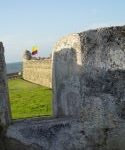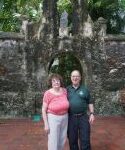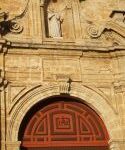December 21,2016
The equinox day
When we got to Cartagena, two things were obvious.
 First, the 32 degrees in latitude and 2300 miles in distance resulted in a temperature gain of 90 degrees. It was -6 when
First, the 32 degrees in latitude and 2300 miles in distance resulted in a temperature gain of 90 degrees. It was -6 when we left home Monday, and 85 degrees when we got here. While that’s not the reason I came here, it was a change; knowing that it would be much warmer here made the trip from the car to the airport terminal even longer. It’s not a motivator for me, but it could well be a satisficer when I go to the coral reef nearby tomorrow for my first scuba dive in anything other than a central Illinois quarry. Do you think I might see something other than rusty buses?
we left home Monday, and 85 degrees when we got here. While that’s not the reason I came here, it was a change; knowing that it would be much warmer here made the trip from the car to the airport terminal even longer. It’s not a motivator for me, but it could well be a satisficer when I go to the coral reef nearby tomorrow for my first scuba dive in anything other than a central Illinois quarry. Do you think I might see something other than rusty buses?
The second change was the time warp—we went to a city where 1533 (its founding) is almost as alive as 2016.
Cartagena, today a city of about one million people, was, during the colonial period, one of the richest of Spain’s possessions. It was, among other things, the leading slave port for the plantations and mines of South America and the Caribbean. (Slavery was abolished in Colombia in 1821, about the time that the Spanish reconquest efforts were defeated by Simon Bolivar). It was also a warehouse on the Atlantic side, but the biggest city close to the Panama/Pacific routes that brought the wealth of the Philippines and elsewhere in Spanish Asia for transshipping to the mother country, where Charles V (among others) could squander the gold and other minerals in wars to keep the Reformation from spreading (in vain).
At one time, there were 18 galleons in port, awaiting a mass departure for Spain; no wonder the French, Dutch, and above all, the English, who had pirates, eyed Cartagena with some interest. No wonder, too, that this became one of the most fortified cities in the Americas. The big fort—thanks to a number of British invasions (Sir Francis Drake occupied the city for two weeks, and only a huge ransom got him to depart; the money went back to Elizabeth I, and Drake died impoverished) is the largest in the Americas, perched atop one of the two hills in town. Naturally, an Augustinian monastery sits on the other.
Small wonder, too, that the old city is walled, and the walls today encircle the tourist town. Many of the buildings and churches have been restored, but as I said, several date back to the 17th century. Our hotel has bikes, and I discovered 630 am is a great time to traverse the
 narrow streets in relative safety, and without the heat of the midday sun. It’s really busy with tourists. One restaurant we wanted to reserve said there were no reservations until after the new year!
narrow streets in relative safety, and without the heat of the midday sun. It’s really busy with tourists. One restaurant we wanted to reserve said there were no reservations until after the new year!
Cartagena is still a major port, with berths for ships that traverse the Panama Canal. That country was once part of Colombia—until the complicated story that led to the Canal Zone and the boast of President Theodore Roosevelt, “I took Panama.”
The recent peace between the FARC rebels and the government ends a 50 year war, but the history of Colombia is rife with similar episodes. One might note that the Spanish conquest (with 200 soldiers) was aided because two of the Indian tribes had been at war with one another. The general tone today among the people we’ve talked with is optimism. Tourism has helped many countries leap stages of economic development. This may be one.